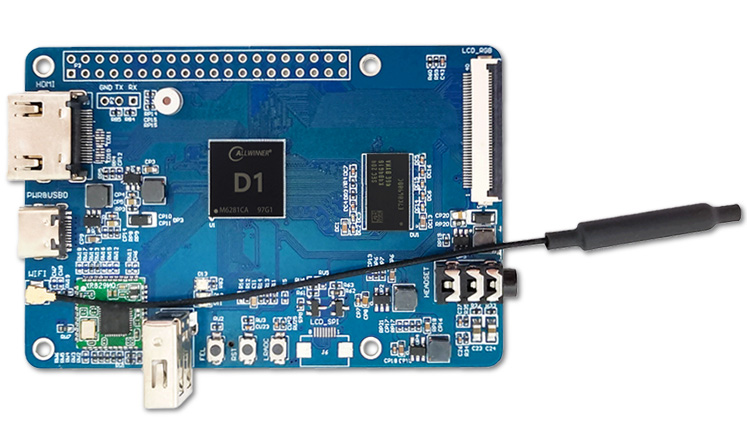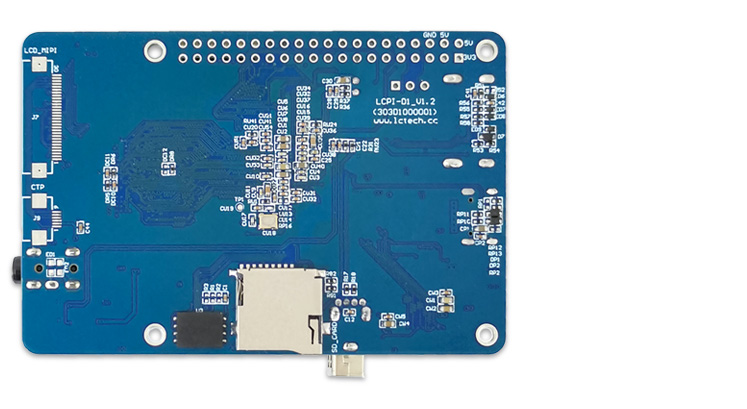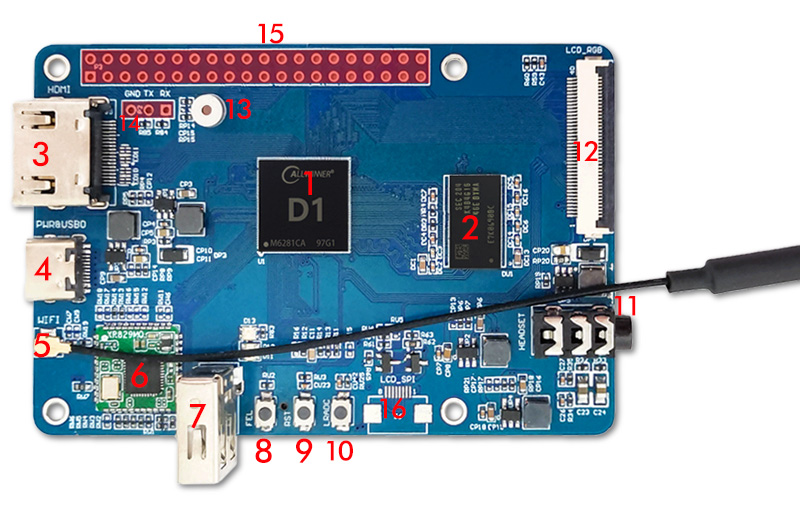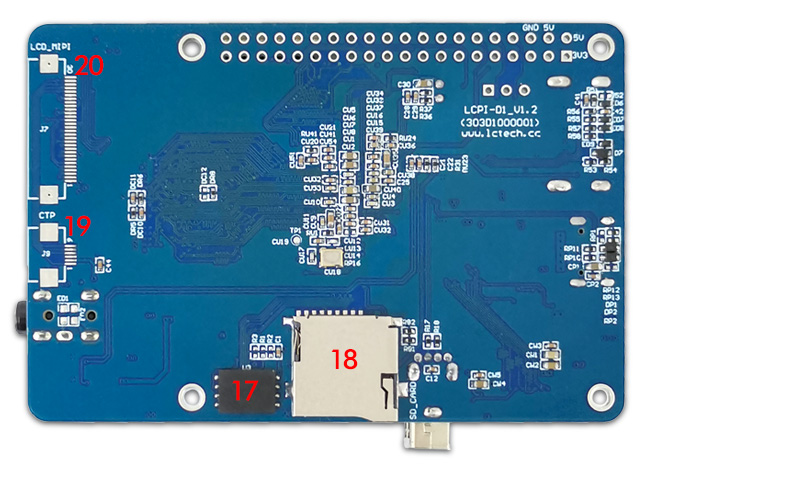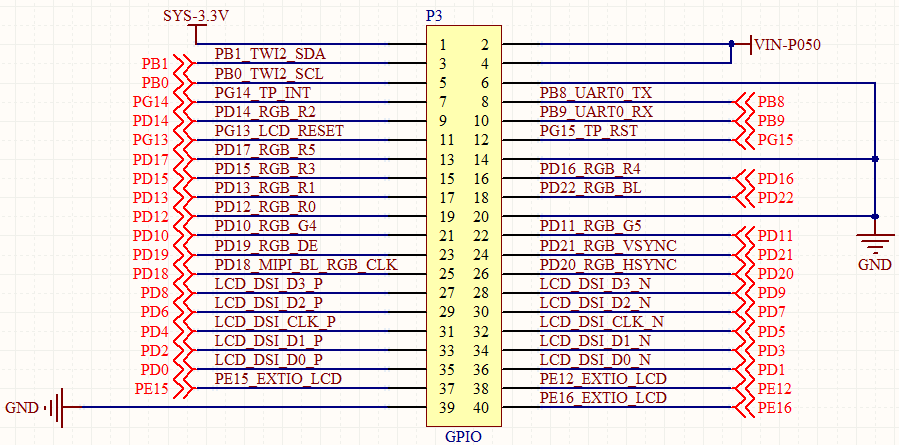Difference between revisions of "LC-PI-D1"
(Created page with "=='''Product name'''== LCPI Allwinner D1 development board 64bit RISC-V Linux SBC supports Tina Debian system<br> ==='''About LCPI D1 development board'''== LC LCPI develop...") |
(→Function features) |
||
| (One intermediate revision by the same user not shown) | |||
| Line 4: | Line 4: | ||
| − | + | =='''About LCPI D1 development board'''== | |
LC LCPI development board is equipped with Allwinner D1 processor.Allwinner D1 is an external processor based on the R18C-V architecture and the world's first general-purpose SOC developed based on Xuantie C906.D1 integrates a 64-bit Xuantie C906 RISC-V CPU, which provides efficient computing power and runs the Linux system, making it stable and efficient, and convenient for secondary development.D1 supports H.265, H.264, MPE-1/2/4, JPEG, VC1 and other full format decoding. A standalone encoder can encode with JPEG or MJPEG.The integrated multi-ADC/DAC and I2S/PCM/DMIC/OWA audio interface can work seamlessly with the CPU to accelerate multimedia algorithms and improve user experience.The development board integrates HDMI, BT2.1+WiFi, 1xUSB OTG+1xUSB Host 1xFEL+1xRST+1xLRADC buttons, 256MB NAND Flash, 4522 model microphone, 3.5mm stereo audio output interface, 40P RGB LCD liquid crystal interface, UART serial port and other rich peripherals and 2*20Pin GPIO outlet.It is not only a microcomputer that can realize audio and video entertainment, but also can be used for Linux programming learning and project development, supporting Debian, Tina and other operating systems.<br> | LC LCPI development board is equipped with Allwinner D1 processor.Allwinner D1 is an external processor based on the R18C-V architecture and the world's first general-purpose SOC developed based on Xuantie C906.D1 integrates a 64-bit Xuantie C906 RISC-V CPU, which provides efficient computing power and runs the Linux system, making it stable and efficient, and convenient for secondary development.D1 supports H.265, H.264, MPE-1/2/4, JPEG, VC1 and other full format decoding. A standalone encoder can encode with JPEG or MJPEG.The integrated multi-ADC/DAC and I2S/PCM/DMIC/OWA audio interface can work seamlessly with the CPU to accelerate multimedia algorithms and improve user experience.The development board integrates HDMI, BT2.1+WiFi, 1xUSB OTG+1xUSB Host 1xFEL+1xRST+1xLRADC buttons, 256MB NAND Flash, 4522 model microphone, 3.5mm stereo audio output interface, 40P RGB LCD liquid crystal interface, UART serial port and other rich peripherals and 2*20Pin GPIO outlet.It is not only a microcomputer that can realize audio and video entertainment, but also can be used for Linux programming learning and project development, supporting Debian, Tina and other operating systems.<br> | ||
| − | |||
| − | |||
=='''LCPI D1 development board view'''== | =='''LCPI D1 development board view'''== | ||
| Line 33: | Line 31: | ||
● 64KB I-ram + 32KB D-ram<br> | ● 64KB I-ram + 32KB D-ram<br> | ||
| − | 3. Video decoding<br> | + | '''3. Video decoding'''<br> |
● H.265 up to 4K@30fps<br> | ● H.265 up to 4K@30fps<br> | ||
● H.264 up to 4K@24fps<br> | ● H.264 up to 4K@24fps<br> | ||
● H.263, MPEG-1/2/4, JPEG, Xvid, Sorenson Spark, up to 1080p@60fps<br> | ● H.263, MPEG-1/2/4, JPEG, Xvid, Sorenson Spark, up to 1080p@60fps<br> | ||
| − | 4. Video encoding<br> | + | '''4. Video encoding'''<br> |
● JPEG/MJPEG 1080p@60fps<br> | ● JPEG/MJPEG 1080p@60fps<br> | ||
● Supports input picture scaler up/down<br> | ● Supports input picture scaler up/down<br> | ||
| − | 5.Memory<br> | + | '''5.Memory'''<br> |
● 1*512MB DDR3<br> | ● 1*512MB DDR3<br> | ||
| − | 6.Onboard storage<br> | + | '''6.Onboard storage'''<br> |
● Self-elastic TF card holder<br> | ● Self-elastic TF card holder<br> | ||
●Onboard 256M Byte SPI NAND Flash chip<br> | ●Onboard 256M Byte SPI NAND Flash chip<br> | ||
| − | 7.Wireless network<br> | + | '''7.Wireless network'''<br> |
● XR829 dual-band WIFI+BT module<br> | ● XR829 dual-band WIFI+BT module<br> | ||
● IEEE 802.11 b/g/n standard<br> | ● IEEE 802.11 b/g/n standard<br> | ||
| Line 55: | Line 53: | ||
● IPEX antenna interface<br> | ● IPEX antenna interface<br> | ||
| − | 8.Video output<br> | + | '''8.Video output'''<br> |
● HDMI V1.4 up to 4K@30fps<br> | ● HDMI V1.4 up to 4K@30fps<br> | ||
● 0.5mm 40Pin RGB LCD interface: supports 5.0 inch 800x480<br> | ● 0.5mm 40Pin RGB LCD interface: supports 5.0 inch 800x480<br> | ||
| − | 9.Audio input<br> | + | '''9.Audio input'''<br> |
● 4522 electret microphone<br> | ● 4522 electret microphone<br> | ||
| − | 10.Audio output<br> | + | '''10.Audio output'''<br> |
● HDMI<br> | ● HDMI<br> | ||
● 3.5mm stereo audio headphone output interface<br> | ● 3.5mm stereo audio headphone output interface<br> | ||
| − | 11.USB interface<br> | + | '''11.USB interface'''<br> |
● 1 X Type-C USB 2.0 OTG<br> | ● 1 X Type-C USB 2.0 OTG<br> | ||
● 1 X Type-A USB 2.0 Hostv | ● 1 X Type-A USB 2.0 Hostv | ||
| − | 12. | + | '''12.GPIO''' |
●Onboard 2.54mm 2*20Pin GPIO pin header (some GPIOs are shared with LCD)<br> | ●Onboard 2.54mm 2*20Pin GPIO pin header (some GPIOs are shared with LCD)<br> | ||
| − | 13.UART<br> | + | '''13.UART'''<br> |
●Onboard 2.54mm 1*3Pin UART pin header<br> | ●Onboard 2.54mm 1*3Pin UART pin header<br> | ||
| − | 14.Power supply<br> | + | '''14.Power supply'''<br> |
●Type-C USB5V 2A and above current power input<br> | ●Type-C USB5V 2A and above current power input<br> | ||
| − | 15.LED lights<br> | + | '''15.LED lights'''<br> |
● 1 X power indicator light (red)<br> | ● 1 X power indicator light (red)<br> | ||
● 1 X programmable LED (green)<br> | ● 1 X programmable LED (green)<br> | ||
● 1 X Programmable WS2812C-2020 RGB lamp bead<br> | ● 1 X Programmable WS2812C-2020 RGB lamp bead<br> | ||
| − | 16. System<br> | + | '''16. System'''<br> |
● Support Debian, Tina and other operating systems<br> | ● Support Debian, Tina and other operating systems<br> | ||
'''Appendix: Allwinner D1 chip interface block diagram'''<br> | '''Appendix: Allwinner D1 chip interface block diagram'''<br> | ||
[[File:D1-4.png]]<br> | [[File:D1-4.png]]<br> | ||
| − | |||
| − | |||
| − | |||
=='''LCPI D1 development board interface introduction'''== | =='''LCPI D1 development board interface introduction'''== | ||
Latest revision as of 14:52, 23 November 2023
Contents
Product name
LCPI Allwinner D1 development board 64bit RISC-V Linux SBC supports Tina Debian system
About LCPI D1 development board
LC LCPI development board is equipped with Allwinner D1 processor.Allwinner D1 is an external processor based on the R18C-V architecture and the world's first general-purpose SOC developed based on Xuantie C906.D1 integrates a 64-bit Xuantie C906 RISC-V CPU, which provides efficient computing power and runs the Linux system, making it stable and efficient, and convenient for secondary development.D1 supports H.265, H.264, MPE-1/2/4, JPEG, VC1 and other full format decoding. A standalone encoder can encode with JPEG or MJPEG.The integrated multi-ADC/DAC and I2S/PCM/DMIC/OWA audio interface can work seamlessly with the CPU to accelerate multimedia algorithms and improve user experience.The development board integrates HDMI, BT2.1+WiFi, 1xUSB OTG+1xUSB Host 1xFEL+1xRST+1xLRADC buttons, 256MB NAND Flash, 4522 model microphone, 3.5mm stereo audio output interface, 40P RGB LCD liquid crystal interface, UART serial port and other rich peripherals and 2*20Pin GPIO outlet.It is not only a microcomputer that can realize audio and video entertainment, but also can be used for Linux programming learning and project development, supporting Debian, Tina and other operating systems.
LCPI D1 development board view
LCPI D1 Dimensional Drawing
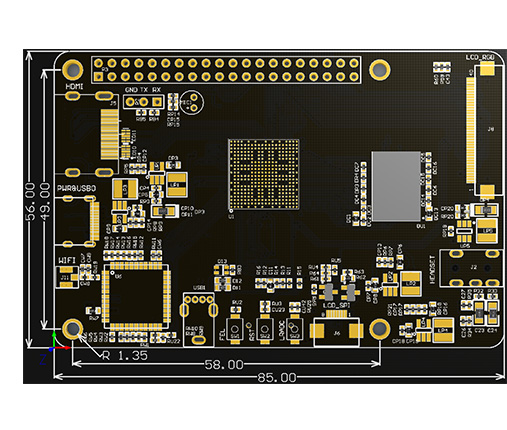
Board size: 85*56mm Weight: 30g
Function features
1.CPU
● XuanTie C906 RISC-V CPU
● 32KB I-cache + 32KB D-cache
2.DSP
● HiFi4
● 32KB I-cache + 32KB D-cache
● 64KB I-ram + 32KB D-ram
3. Video decoding
● H.265 up to 4K@30fps
● H.264 up to 4K@24fps
● H.263, MPEG-1/2/4, JPEG, Xvid, Sorenson Spark, up to 1080p@60fps
4. Video encoding
● JPEG/MJPEG 1080p@60fps
● Supports input picture scaler up/down
5.Memory
● 1*512MB DDR3
6.Onboard storage
● Self-elastic TF card holder
●Onboard 256M Byte SPI NAND Flash chip
7.Wireless network
● XR829 dual-band WIFI+BT module
● IEEE 802.11 b/g/n standard
● Blutooth V2.1+EDR/4.0
● IPEX antenna interface
8.Video output
● HDMI V1.4 up to 4K@30fps
● 0.5mm 40Pin RGB LCD interface: supports 5.0 inch 800x480
9.Audio input
● 4522 electret microphone
10.Audio output
● HDMI
● 3.5mm stereo audio headphone output interface
11.USB interface
● 1 X Type-C USB 2.0 OTG
● 1 X Type-A USB 2.0 Hostv
12.GPIO
●Onboard 2.54mm 2*20Pin GPIO pin header (some GPIOs are shared with LCD)
13.UART
●Onboard 2.54mm 1*3Pin UART pin header
14.Power supply
●Type-C USB5V 2A and above current power input
15.LED lights
● 1 X power indicator light (red)
● 1 X programmable LED (green)
● 1 X Programmable WS2812C-2020 RGB lamp bead
16. System
● Support Debian, Tina and other operating systems
Appendix: Allwinner D1 chip interface block diagram
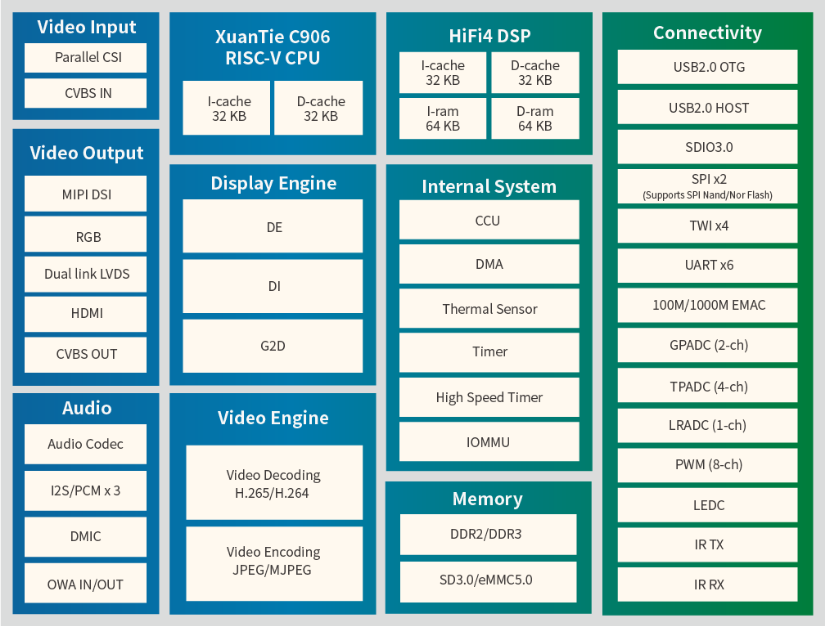
LCPI D1 development board interface introduction
1. Allwinner D1 XuanTie C906 RISC-V processor
2. DDR3 memory chip: 1 x 512M Byte
3. HDMI interface: supports connection to a monitor/TV with HDMI interface, supports HDMI audio output
4. Type-C USB socket: power supply & 2.0 USB0 OTG, 5V/2A or above current power supply recommended
5. IPEX WiFi&BT antenna interface
6. XR829 dual-band WIFI+Bluetooth V2.1 module
7. 1 x 2.0 USB1 Host interface
8. FEL key: Press and hold to power on the device to enter FEL programming mode
9. RST key: Press it briefly to reset and restart the device.
10. LRADC key: ADC programmable key
11. 3.5mm stereo headphone jack
12. 0.5mm 40Pin FPC connected to RGB LCD interface: supports 4.3-inch 480x272/5.0-inch 800x480 LCD (but currently there are only images that drive 5.0 inch screens!)
13. 4522 electret microphone
14. UART interface: When in use, GND, TX, and RX are connected to the GND, RX, and TX of the external TTL module respectively.
15. 2.54mm 2*20Pin GPIO outlet: Some GPIO are shared with LCD driver IO, please pay attention when using it!
16. 0.5mm 8Pin FPC connected to 1.14 inch (TODO) SPI LCD interface: only reserved and not soldered!!!
17. 256M Byte Nand Flash: Model MX35LF2GE4AD-Z4I
18. Self-elastic TF card holder
19. 0.5mm 6Pin FPC connected to touch screen interface: only reserved and not soldered!!!
20. 0.5mm 30Pin FPC connected to 8.0-inch 1280x720 (ILI9881C) MIPI LCD interface: only reserved and not soldered!!!
Introduction to GPIO and LCD interface
● 0.5mm 40Pin RGB LCD interface
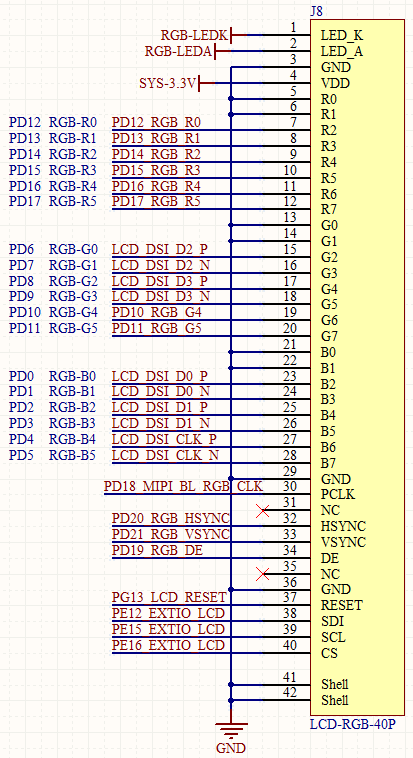
● 0.5mm 30Pin MIPI LCD interface (not soldered yet)
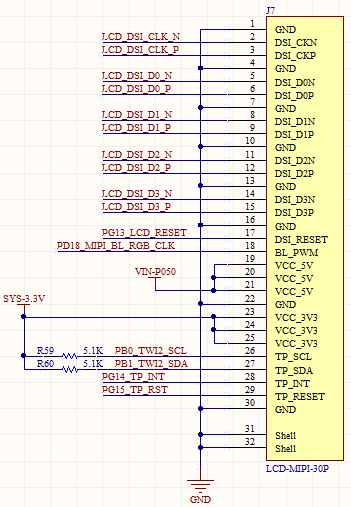
● 0.5mm 6Pin touch screen interface (not soldered yet)
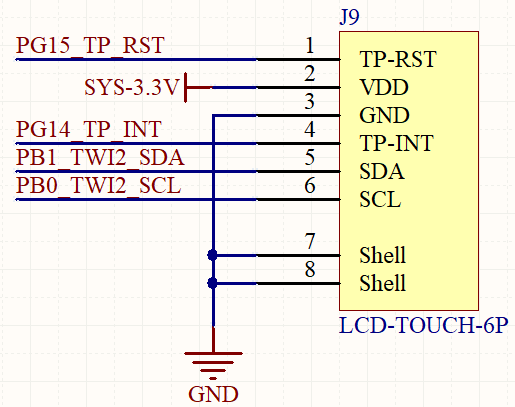
Download LCPI-D1 User Manual
For more information about the use of LCPI-D1, please click Google Drive Link.
